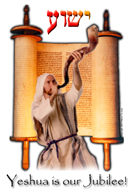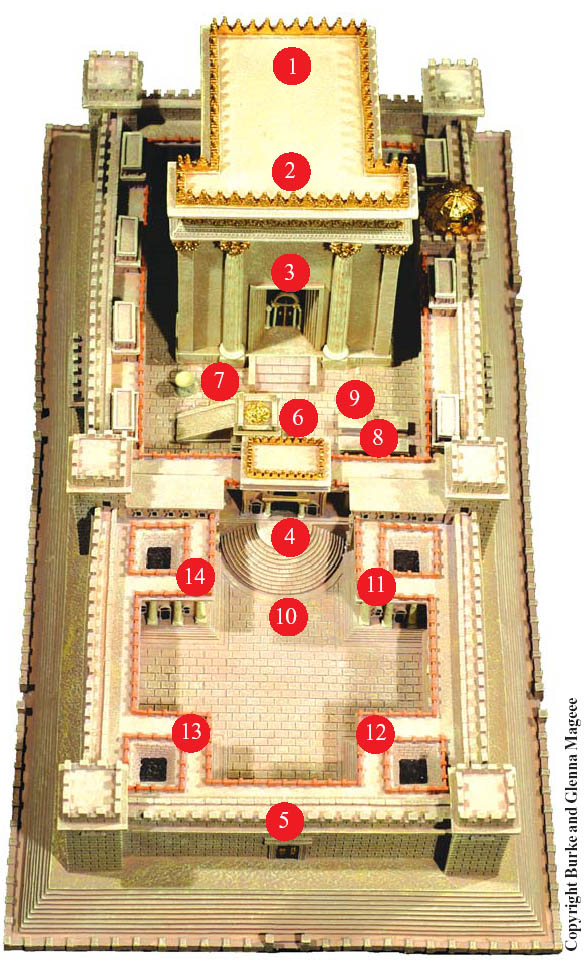

“Howbeit
the most High dwelleth not in temples made with hands;
as saith the prophet,” - Acts 7:48
“... for ye [believers] are the temple of the living God;
as God hath said, I will dwell in them,
and walk in them; and I will be their God, and they shall be my people.”
- 2 Corinthians 6:16
The
second temple was erected by the exiles on their return from Babylon.
About five hundred years later, Herod the Great became king of Judea.
The Temple building had suffered from natural decay and attacks from enemies.
Herod, wanting to gain the favor of the Jews, proposed to rebuild it.
The work on the main
part of the Temple building began in 18 B.C. and was completed in ten
years. The erection of the outer courts of the Temple and embellishment
of the Temple
proceeded during Yeshua's life. The work was completed in 65 A.D., leaving
the new Temple Complex approximately 45 acres, or about 15 percent of
the area of Jerusalem. The second Temple was destroyed by the Romans in
70 AD in fulfillment of
Yeshua's prediction in Luke 19:41-44.
The
Third Temple (Future) It appears from 2 Thessalonians 2:3-4, Revelation
11:1-2 and Daniel 9:27 that a third Temple will be at least partially
in place during the End Times:
“Now
we beseech you, brethren, by the coming of our Lord Jesus Christ, and
by our gathering together unto him...for that day shall not come, except
there come a falling away first, and that
man of sin be revealed, the son of perdition; Who opposeth and exalteth
himself above all that is called God, or that is worshiped; so that he
as God sitteth in the temple of God, showing himself
that he is God.”
- 2 Thessalonians 2:1-4
Although
Temple vessels are being made in preparation for a third Temple, the Temple
is no longer
necessary because Yeshua is our Temple. Yeshua alluded to this after driving
out the money changers
from the second Temple complex when He said to the Jews: “Destroy
this temple, and in three days I
will raise it up.” - John 2:19. They did not understand how the
Temple could be rebuilt in three days, “But
he spake of the temple of his body.” - John 2:21
When
Yeshua dwells with us, He will be our Temple and believers will be “as
lively [living] stones, are
built up a spiritual house, an holy priesthood, to offer
up spiritual sacrifices, acceptable to God by Jesus Christ.”
- 1 Peter 2:5
The
new Temple will not be built of materials like
physical stones, but “built upon the foundation of the
apostles and prophets, Jesus Christ himself being the chief cornerstone.”
- Ephesians 2:20-22

The Holy of Holies was located at the westernmost part of the Temple. It was an area 20 cubits1 square by 40 cubits1 high (29.5 sq. ft. x 59.1 ft. high). Contained in the Holy of Holies was the Ark of the Covenant on a stone. The Ark contained the Ten Commandments given to Moses by God on Mount Sinai, Aaron's rod that sprouted, and a jar of manna. When Yeshua was on earth, the Ark was not present in the Temple.
2
Sanctuary (Heichal)
The Sanctuary was 20 cubits wide and 40 cubits long (29.5 ft. x 59.1 ft.).
It contained the Golden Table upon which rested the Panim Bread (Lehem
Hapanim), a gold Menorah, and the Altar of Incense.
3
Sanctuary Entrance
The Sanctuary entrance was 20 cubits high and 10 cubits wide (29.5 ft.
x 14.8 ft.). It had two sets of doors covered with gold.
4
Nicanor Gate
This gate is the entrance to the court of the Priests. It was named after
an Alexandrian who donated the magnificent doors crafted from Corinthian
Bronze.
5
Eastern Gate
The entrance to the Court of the Women.
6
Altar of Sacrifice
The Altar of Sacrifice measured 32 cubits square and 15 cubits high (47.3
sq.ft. x 22.2ft.) and was approached from the south via a ramp. On special
occasions, such as the Day of Atonement, four fires burned, one at each
corner. There was a horn at each corner of the altar with a grove cut
into it, down which was poured blood, water, and oil. Yeshua is our sacrifice,
upon which we must place our sins for His atoning sacrifice that is forever!
7
The Great Laver (wash basin or Kiyor)
The Kiyor was placed between the Altar and the Sanctuary as stated in
the Torah. It was used by the priests (Kohanim) to wash their hands and
feet. Water for sacrifice was drawn from underground cisterns.
8
Sacrifice Marble Tables
Eight marble tables were located north of the Altar near the meat hangers,
the place where the animals were slaughtered and prepared for eating or
sacrificial burning on the Altar. This was the most sacred side of the
Altar. Yeshua would have to be sacrificed north of the Altar to be considered
an acceptable sacrifice (Leviticus 1:11). This why it is likely that He
was crucified just north of the Temple on Mount Moriah.
9
Court of the Priests
The area between the Nicanor Gate and the Temple was known as the Court
of the Priests. This area contained the Altar, the Laver, tables and hangers.
Only the male Levites could enter this sacred court. The area was approximately
11 cubits by 135 cubits (16.2 ft.x 199.4 ft.)
10
Court of Prayer
(Court of the Women)
This court was not exclusively for women, but was so named because it
was the limit that women could enter the Temple area. It was a later addition
to the Temple court. This area was approximately one-third of the Temple
court area. It contained four chambers, one at each corner.
11
Chamber of Leper (Metzorah)
This chamber served as a gathering place for people with a Biblical skin
disease caused by speaking slander. It was only diagnosed by a qualified
Priest (Kohain).
12
Chamber of Wood
This chamber stored the Altar wood. Kohanim examined all wood to ensure
it was insect-free for use on the Altar.
13
Chamber of Nazarites
This chamber was where the offerings of the Nazarites were cooked and
where their newly shorn hair was burned.
14
Chamber of Oil and Wine
This chamber stored the olive oil for the great Menorahs and meal offerings.